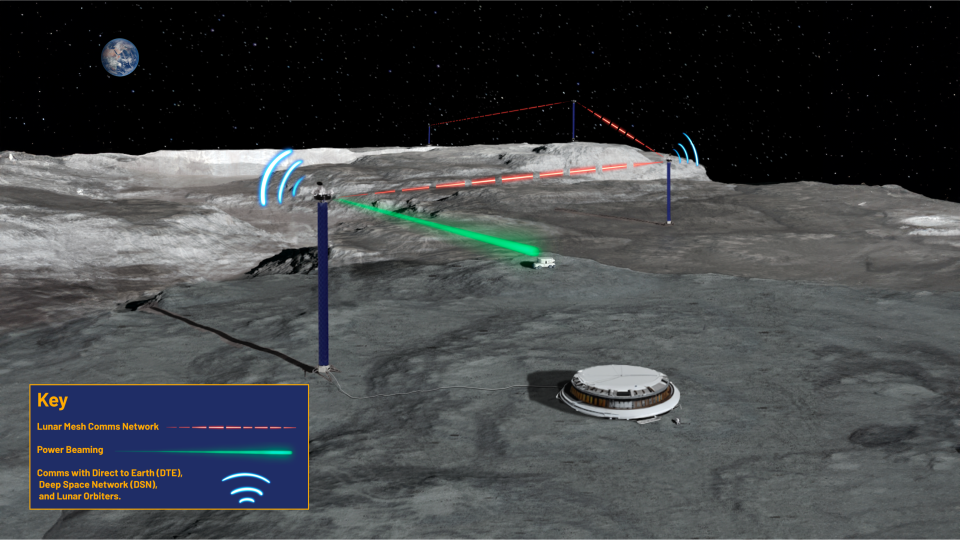A lighthouse for the moon – bright idea.
In long form engineering it is called Lunar Utility Navigation with Advanced Remote Sensing and Autonomous Beaming for Energy Redistribution, or LUNARSABER. The idea comes from Honeybee Robotics, a concept selected as part of the Defense Advanced Research Projects Agency’s 10-year Lunar Architecture (LunA-10) initiative.
This power tower would be nearly 330 feet (100 meters) tall, a deployable structure topped with solar panels that integrates things like power storage and transfer, communications, as well as location, navigation, and timing, even surveillance capability into one. infrastructure.
Honeybee Robotics technologists expect that LUNARSABER can be scaled to over 650 feet (200 meters) high above the lunar landscape to increase its range of services. “LUNARSABER can be above the lunar horizon and see the sun at all times if we are in the south pole of the moon,” said Kris Zacny, vice president of Exploration Systems at Honeybee Robotics in Altadena, California. “Right on top of the structure are cameras, communication systems. We have a flood light to illuminate areas for rovers,” Zacny told Space.com. “You put one or two of them at the south pole of the moon and you cover the whole area. That’s your lighthouse,” he said.
Related: The moon has been changed by human activity. Are we in a ‘Lunar Anthropocene?’
Deployable structure
Vishnu Sanigepalli is Honeybee’s principal investigator on LUNARSABER on the DARPA LunA-10 effort.
Sanigepalli said there was speculation that the poles of the moon would have peaks of perpetual light when the deployment of solar panels would help generate power throughout the year.
But after NASA’s Lunar Reconnaissance Orbiter (LRO) mapped out the moon, it was discovered that there are no locations near the poles that receive sunlight consistently throughout the year.
“A lot of analysis has been done using the topography of the moon where it was found that the rim of a crater near the South Pole has long lunar days because of their height, but not 100 percent,” said Sanigepalli.
Being directly at the lunar south pole will not result in long lunar days. You would also have to be located at the highest mountain feature or crater.

Location and height
“If we have the ability to build tall structures near the south poles, we can basically ensure that there is more than 95 percent illumination during the lunar year,” Sanigepalli said. “This depends on the location and the height,” he said.
Sanigepalli said the rims of the craters are an ideal choice because they are already elevated. Building even taller structures, more than 1,640 feet (500 meters) tall, can boost expansion into other regions and locations on the moon.
Utility solution
For moon setting, Sanigepalli said, continuous lighting is not enough. “We also need to communicate with Earth to keep lunar rovers, robotic systems, and other equipment running. So, it becomes an optimization of lighting for power and direct communication to Earth,” said he.
LUNARSABER can enable resource utilization on the moon as it is a highly adaptable utility solution that would lay the foundation for a thriving lunar economy, according to the firm.
“We look forward to partnerships with both commercial and non-commercial customers to host payloads and services that will help accelerate lunar infrastructure,” Sanigepalli said.


Red Water
While the promotion of lunar exploration ideas is at a near-term high, Honeybee Robotics is also developing RedWater, a mining system that aims to drill into the surface of Mars and melt/extract water from specific areas of the Red Planet .
“This mining system would go thousands of meters deep, going into the submarine ice, then melt and pump water to the surface,” Zacny said. “It’s a robotic system capable of planetary mining and drilling,” he said, and could extract thousands of tons of water from Mars’ underground ice deposits.
RedWater is another In-Situ Resource Utilization (ISRU) technology that can and does support human exploration of Mars by mining water used for everything from life support and agriculture to fuel cells and propulsion.
RAT and scoop
RELATED STORIES:
— DARPA-funded ‘Inchworm’ robots could help us build moon bases. This is how
— The US Space Force has new guidelines for working on and around the moon
— Why is there so much military interest in the moon?
Honeybee Robotics is no stranger to designing, building and landing their hardware on other worlds. The innovative company provided the Rock Abrasion Tool (RAT) that was used on NASA’s Spirit and Opportunity Mars exploration rovers that landed on the Red Planet in January 2004.
Their hardware was also deployed and demonstrated on NASA’s 2008 Mars Phoenix Lander mission. That Icy Soil Holding Device was called the “Phenix Scoop”.
NASA’s two active Mars rovers, Curiosity and Perseverance, also have equipment supplied by Honeybee Robotics.
Japan’s Martian Moons Exploration (MMX) mission, now slated for a 2026 launch, is embedded with a P-sampler supplied by Honeybee Robotics. That device is located along the leg of the MMX lander, which is designed to conduct sampling operations after the Japanese probe lands on Phobos.
Making mechanisms to work outside of Earth is a challenge, Zacny said, “but that’s part of the fun of developing something from scratch. Otherwise our life would be boring if you had cookie-cutter robots.”